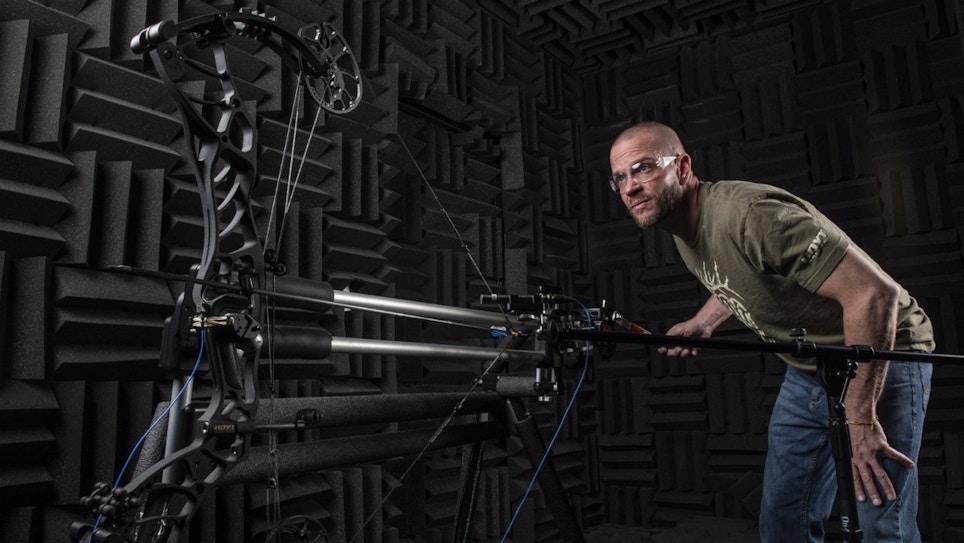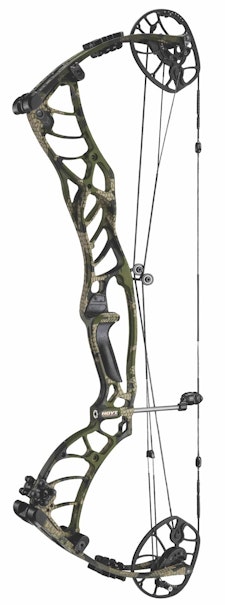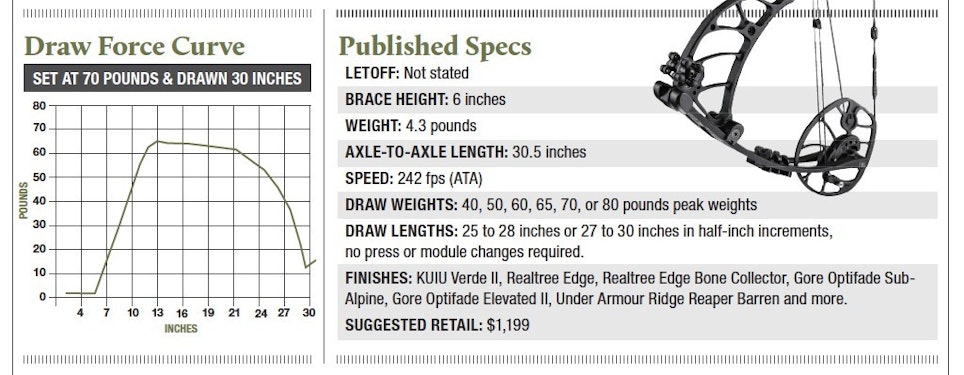Hoyt’s carbon riser bows get a lot of media attention, and deservedly so. But as I’ve pointed out in the past, Hoyt’s aluminum bows are remarkably close to the carbon bows in quality and performance, and at a significantly lower price. That’s not a slam at the carbon bows, a couple of which have been among my go-to bows in recent years — I’m just pointing out that you needn’t be on a tight budget to choose a Hoyt aluminum bow over a carbon one. And that choice might be even easier with the introduction this year of the Hoyt Helix.
To put it simply, there is a lot of new stuff on this bow. There are some proven Hoyt design features, to be sure, but there is a lot of new technology as well. And most of it is aimed at making this bow smoother shooting and quieter than recent Hoyt offerings, which it is. How did they accomplish this? First, to state what is often overlooked because it’s so basic, the Helix at 4.3 pounds is a little heavier than most of Hoyt’s recent offerings. That is not an inordinately heavy bow at all, but the extra few ounces are noticeable. All else being equal (repeat after me: which it never is), a heavier bow will be quieter and closer to dead in the hand than a lighter bow. Hoyt has also added some new noise and vibration killers in the form of a new Shock Pod system on the lower part of the riser, some interesting string silencers with openings that increase in size at full draw and close at the shot, and new material on the StealthShot string suppressor that Hoyt touts as superior to the material it replaced. A rubber pad on the shelf reduces noise from arrows clacking against the riser as well as from drop-away rests hitting the shelf as they drop.
The ZT (Zero Torque) Pro Cam employs Hoyt’s recently introduced yoked cable system, but the cam system itself is touted as faster and smoother than its predecessor while affording the highest letoff Hoyt has yet offered. As a side note, the yoked cable makes it possible to tie in a drop-away rest cable without the need to press the bow. The yoked cam system also reduces cam lean and torque, eliminating the need for a flexible cable guard. This system allows for draw length adjustments without changing modules, which (in my opinion) offers a lot of advantages. The roller guard keeps friction to a minimum, which should increase speed and extend the life of the cables. The grip is new, as well, and while there are certainly skinnier grips on the market, this grip is skinnier than most of Hoyt’s offerings; it’s comfortable and wraps around enough of the riser to make it warm on cold outings. What’s not so new? The zero-tolerance limb pockets are proven features, and the rear stabilizer mount is back for shooters obsessed with balance. The bridged riser is familiar in concept though in this application it looks, as well as feels, a little heavier.
Fit and finish is what you’d expect from a Hoyt — flawless and durable. The black grip, shelf, limb pockets and accessories contrast nicely with any of the camo finishes. The understated logos add a little class to a bow that, to my eyes, is pleasing.
Shooting the Hoyt Helix
Limb bolts were snug but turned smoothly to adjust draw weight. Draw length changes were also easily accomplished, via a torx wrench, as opposed to the more commonly used hex wrench. All accessories installed without difficulty, and paper tuning took less than 15 minutes.
The grip has already been referenced; I found it quite comfortable. The bow does draw a little more smoothly than other recent Hoyt offerings, at least with regard to hunting bows. And it is slightly, but noticeably quieter. I have not found vibration to be an issue with recent Hoyt bows, but this bow is closer to dead-in-the-hand, and does not pop forward as sharply as many bows. Any well-engineered compound bow with a maximum speed of 230 fps or so should be pleasant to shoot, while any bow that shoots at 250 fps or more is going to sacrifice at least a little shootability. Bows like the Helix that split the difference are going to fall right into the sweet spot for many shooters.
Shooters accustomed to a lighter bow will notice the weight, though it is only a matter of a few ounces. I certainly would have no hesitation in hunting with this bow from a treestand or ground blind. Ultimately, the test for any new bow is, does it advance the state of the art in terms of speed, shootability, or price, or does it fill a niche previously unoccupied by that manufacturer? The Hoyt Helix, while not radically new or different, is an excellent bow providing the bomb-proof durability and general quality that Hoyt has become noted for, while offering a noticeably quieter, smoother shooting experience.
How We Test
- Each bow is carefully inspected out of the box for fit and finish and for any visible defects in workmanship. Axle-to-axle length, brace height, mass weight and draw length are measured and compared with stated specs. Minor discrepancies in draw length are corrected or noted.
- A QAD UltraRest is installed, and each bow is equipped with a TruGlo sight, a TruGlo stabilizer, a G5.25-inch Metapeep and a D-loop. Test arrows are Carbon Express Maxima Red arrows at weights of 385 and 440 grains, fletched with Bohning Blazer vanes and fitted with QAD Tune-A-Nocks. Peak draw weight is established, and draw force curves, along with letoff, are determined using an Easton Bow Force Mapping System.
- Using a Spot-Hogg Hooter Shooter bow-shooting machine and a ProChrono chronograph, arrow speed and kinetic energy are measured at point of launch and at 20 yards.
- Sound is measured with an NM102 Sound Level Meter with mic positioned 3 feet in front of the bow and 18 inches under the arrow flight path.
- All bows are pressed on a Buckeye Archery Solutions Bow-A-Constrictor press.









